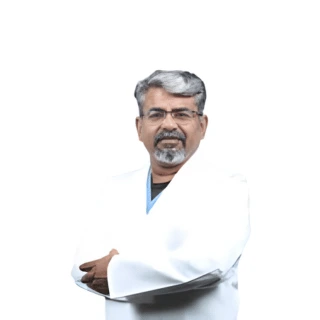Best Liver Transplant Surgeons in Artemis Hospital Gurgaon
 24 December,2025
Read More
24 December,2025
Read More
Starting From: USD 800 - USD 1100
Hospitalization Days: 1 - 2 Days
Procedure Duration: 30 Min - 60 Min
Percutaneous Nephrostomy Drainage Procedure is affordable in India. The cost of Percutaneous Nephrostomy Drainage Procedure in India lies between USD 800 - USD 1100. The exact procedure price depends on multiple factors such as the surgeon's experience, type of hospital, severity of the condition, patient's general condition,�etc.
Percutaneous nephrostomy is a minimally invasive procedure used to drain urine from the kidney when normal urine flow is obstructed. A needle is inserted through the skin and kidney under imaging guidance. A catheter is then passed through the needle into the renal pelvis, allowing urine to drain into an external collection bag. This procedure is commonly used to relieve urinary tract obstruction caused by conditions such as kidney stones, tumors, or ureteral strictures. Depending on the underlying condition, it provides temporary or long-term relief and can improve kidney function and alleviate symptoms associated with urinary obstruction.
Percutaneous nephrostomy and drainage are necessary when a blockage in the urinary tract prevents normal urine flow from the kidney to the bladder. This obstruction can result from various conditions such as kidney stones, tumors, ureteral strictures, or congenital abnormalities. Here's why percutaneous nephrostomy and drainage are needed:
Percutaneous nephrostomy and drainage encompass various techniques and approaches tailored to the specific needs of patients with obstructive uropathy or other urinary tract disorders. Here are the types of percutaneous nephrostomy and drainage:
Selecting patients for percutaneous nephrostomy and drainage involves a comprehensive evaluation by a multidisciplinary team comprising interventional radiologists, urologists, nephrologists, and other specialists. Several factors influence the decision-making process:
Percutaneous nephrostomy and drainage offer risks and benefits that patients and healthcare providers should consider carefully. Here's an overview of the risks and benefits associated with the procedure:
Percutaneous nephrostomy and drainage is a minimally invasive procedure performed by interventional radiologists or urologists to alleviate urinary obstruction by providing an alternative route for urine drainage from the kidney. Here's an overview of how the procedure is typically performed:


Chairman
HPB and Liver Transplant Surgeon
Medanta - The Medicity Hospital, Gurgaon

Consultant
Gastroenterologist
Manipal Hospital Formerly Columbia Asia, Palam Vihar, Gurgaon

Consultant
Gastroenterologist, Hepatologist
Manipal Hospital Formerly Columbia Asia, Palam Vihar, Gurgaon
Doctor of Pharmacy
Dr. Deepanshu Siwach is a skilled clinical pharmacist with a Doctor of Pharmacy degree.?He has 4+?years of experience and has worked with thousands of patients. He has been associated with some of the top hospitals, such as Artemis Gurgaon.
Dr. Deepanshu Siwach is a skilled clinical pharmacist with a Doctor of Pharmacy degree.?He has 4+?years of experience and has worked with thousands of patients. He has been associated with some of the top hospitals, such as Artemis Gurgaon....
Director
Hepatologist, HPB and Liver Transplant Surgeon, Surgical Gastroenterologist
Aakash Healthcare Super Speciality Hospital, Dwarka, New Delhi
Dr. Ajitabh Srivastava is one of the best Hepatologists, Surgical Gastroenterologists, and Liver Transplant Surgeons in New Delhi. With over 26 years of experience, he has performed over 2500 liver transplant procedures. He specializes in hepato-pancreato-biliary (HPB) surgery, gastrointestinal surgery, acute liver failure treatment, laparoscopic surgery, and gall bladder surgery....
Percutaneous nephrostomy and drainage typically take 30 minutes to an hour to complete. However, the duration may vary depending on factors such as the anatomy's complexity, the obstruction's severity, and the patient's overall health. Additionally, pre-procedural preparation and post-procedural monitoring may extend the total time spent in the hospital or outpatient setting.
The success rate of percutaneous nephrostomy and drainage is high, with the procedure effectively relieving urinary obstruction in most cases. Success rates vary depending on factors such as the underlying cause of obstruction, the patient's overall health, and the expertise of the healthcare team performing the procedure. Generally, success rates range from 80% to 95% in appropriately selected patients.
After percutaneous nephrostomy and drainage, patients typically experience minimal discomfort or pain at the catheter insertion site. They may resume normal activities within a few days but should avoid heavy lifting or strenuous activities for a short period. Regular follow-up appointments are scheduled to monitor the drainage and assess the need for catheter maintenance or removal.
After percutaneous nephrostomy and drainage, patients may receive pain management through over-the-counter or prescription medications, depending on the severity of discomfort. Nonsteroidal anti-inflammatory drugs (NSAIDs) or acetaminophen are commonly used to alleviate mild to moderate pain. Stronger pain medications may sometimes be prescribed to manage more severe discomfort.
Patients can typically resume normal activities within a few days after percutaneous nephrostomy and drainage, depending on their recovery and the severity of their condition. However, as advised by healthcare providers, strenuous activities should be avoided for a short period. Patients are encouraged to gradually increase activity levels based on their comfort and recovery progress.
The duration of percutaneous nephrostomy and drainage varies depending on factors such as the underlying cause of urinary obstruction and the patient's response to treatment. In some cases, nephrostomy tubes may be left in place temporarily until the obstruction resolves, while in others, they may be required long-term or replaced with other interventions such as ureteral stenting or surgical correction.
After percutaneous nephrostomy and drainage, patients may need to make certain lifestyle adjustments to ensure optimal recovery and management. These may include maintaining good hygiene around the catheter site, monitoring urine output and drainage bag, adhering to any prescribed medications or dietary recommendations, and attending regular follow-up appointments with healthcare providers for monitoring and management.
Alternative treatments for percutaneous nephrostomy and drainage depend on the underlying cause of urinary obstruction. Options may include ureteral stenting, retrograde ureteral catheterization, endoscopic procedures such as ureteroscopy or nephrolithotomy, or surgical interventions to address the obstructive condition directly. Treatment selection is based on factors such as the severity of obstruction, patient preferences, and the expertise of the healthcare team.
The Art of Effective Communication
 24 December,2025
Read More
24 December,2025
Read More
 23 December,2025
Read More
23 December,2025
Read More
 17 December,2025
Read More
17 December,2025
Read More
 16 December,2025
Read More
16 December,2025
Read More
 10 December,2025
Read More
10 December,2025
Read More
 09 December,2025
Read More
09 December,2025
Read More